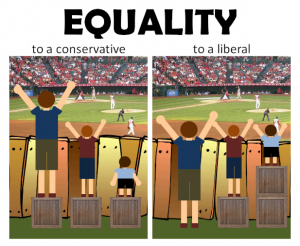“You keep using that word. I do not think it means what you think it means“
That now famous quote was uttered by the character Inigo Montoya in the movie, The Princess Bride. In recent years, the phrase has been co-opted for its apparent usefulness in mocking people during online debates. While I enjoy a good internet argument as much as the next person, I do try to stay out of them these days due to time constraints, though I did used to be something of a chronic debater. (As an aside, I started this blog, at least in part, for reasons owing to balancing my enjoyment of debates with those time constraints. It’s worked pretty well so far). As any seasoned internet (or non-internet) debater can tell you, one of the underlying reasons debates tend to go on so long is that people often argue past one another. While there are many factors that explain why people do so, the one I would like to highlight today is semantic in nature: definitional obscurity. There are instances where people will use different words to allude to the same concept or use the same word to allude to different concepts. Needless to say, this makes agreement hard to reach.
But what’s the point of arguing if it means we’ll ever agree on something?
This brings us to the question of intentions. Defined by various dictionaries, intentions are aims, plans, or goals. By contrast, the definition of a side effect is just the opposite: an unintended outcome. Were these terms used consistently, then, one could never say a side effect was intended; foreseen, maybe, but not intended. Consistency, however, is rarely humanity’s strongest suit – as we ought expect it not to be – since consistency does not necessarily translate into “useful”: there are many cases in which I would be better off if I could both do X and stop other people from doing X (fill in ‘X’ however you see fit: stealing, having affairs, murder, etc). So what about intentions? There are two facts about intentions which make them prime candidates for expected inconsistency: (1) intentionally-committed acts tend to receive a greater degree of moral condemnation than unintentional ones, and (2) intentions are not readily observable, but rather need to be inferred.
This means that if you want to stop someone else from doing X, it is in your best interests to convince others if someone did X, that X was intended, so as to make punishment less costly and more effective (as more people might be interested in punishing, sharing the costs). Conversely, if you committed X, it is in your best interests to convince others that you did not intend X. It is on the former aspect – condemnation of others – that we’ll focus on here. In the now classic study by Knobe (2003), 39 people were given the following story:
The vice-president of a company went to the chairman of the board and said, “We are thinking of starting a new program. It will help us increase profits, but it will also harm the environment.” The chairman of the board answered, “I don’t care at all about harming the environment. I just want to make as much profit as I can. Let’s start the new program.’”They started the new program. Sure enough, the environment was harmed.
When asked whether the chairman intentionally harmed the environment, 82% of the participants agreed that he had. However, when the word “harm” was replaced with “help”, now 77% of the subjects said that the benefits to environment were unintentional (this effect was also replicated using a military context instead). Now, strictly speaking, the only stated intention the chairman had was to make money; whether that harmed or helped the environment should to be irrelevant, as both effects would side effects of that primary intention.Yet that’s not how people rated them.
Related to the point about moral condemnation, it was also found that participants said the chairman who brought about the negative side effect deserved substantially more punishment (4.8 on a 0 to 6 scale) than the chairman who brought about the positive impact deserved praise (1.4), and those ratings correlated pretty well with the extent to which the participants thought the chairman has brought about the effect intentionally. This tendency to asymmetrically see intentions behind negative, but not positive, side effects was dubbed “the side-effect effect”. There exists the possibility, however, that this label is actually not entirely accurate. Specifically, it might not be exclusive to side effects of actions; it might also hold for the means by which an effect is achieved as well. You know; the things that were actually intended.
Just like how this was probably planned by some evil corporation.
The paper that raised this possibility (Cova & Naar, 2012) began by replicating Knobe’s basic effect with different contexts (unintended targets being killed by a terrorist bombing as the negative side effect, and an orphanage expanding due to the terrorist bombing as the positive side effect). Again, negative side effects were seen as more intentional and more blameworthy than positive side effects were rated as intentional and praiseworthy. The interesting twist came when participants were asked about the following scenario:
A man named André tells his wife: “My father decided to leave his immense fortune to only one of his children. To be his heir, I must find a way to become his favorite child. But I can’t figure how.” His wife answers: “Your father always hated his neighbors and has declared war to them. You could do something that would really annoy them, even if you don’t care. Andre decides to set fire to the neighbors’ car.
Unsurprisingly, many people here (about 80% of them) said that Andre had intentionally harmed his neighbors. He planned to harm them, because doing so would further another one of his goals (getting money) A similar situation was also presented, however, where instead of burning down the neighbor’s car, Andre donates to a humanitarian-aid society because his father would have liked that. In that case, only 20% of subjects reported that Andre had intended to give money to the charity.
Now that answer is a bit peculiar. Surely, Andre intended to donate the money, even if his reason for doing so involved getting money from his father. While that might not be the most high-minded reason to donate, it ought not make the donating itself any less intentional (though perhaps it seems a bit grudging). Cova & Naar (2012) raise the following alternative explanation: the way the philosophers tend to use the word “intention” is not the only game in town. There are other possible conceptions that people might have of the word based on the context in which it’s found, such as, “something done knowingly for which an agent deserves praise of blame“. Indeed, taking these results at face value, we would need something else beyond the dictionary definitions of intention and side effect, since they don’t seem to be applying here.
This returns us to my initial point about intentions themselves. While this is an empirical matter (albeit a potentially difficult one), there are at least two distinct possibilities: (a) people mean something different by “intention” in moral and nonmoral contexts (we’ll call this the semantic account), or (b) people mean the same thing in both cases, but they do actually perceive it differently (the perceptual account). As I mentioned before, intentions are not the kinds of things which are readily observable, but rather need to be inferred, or perceived. What was not previously mentioned, however, is that it is not as if people only have a single intention at any given time; given the modularity of the mind, and the various goals one might be attempting to achieve, it is perfectly possible, at least conceptually, for people to have a variety of different intentions at once – even ones that pull in opposite directions. We’re all intimately familiar with the sensation of having conflicting intentions when we find ourselves stuck between two appealing, but mutually-exclusive options: a doctor may intend to do no harm, intend to save people’s lives, and find himself in a position where he can’t do both.
For whatever it’s worth, of the two options, I favor the perceptual account over the semantic account for the following reason: there doesn’t seem to be a readily-apparent reason for definitions to change strategically, though there are reasons for perceptions to change. Let’s return to the Andre case to see why. One could say that Andre had at least two intentions: get the inheritance, and complete act X required to achieve the inheritance. Depending on whether one wants to praise or condemn Andre for doing X, one might choose to highlight different intentions, though in both cases keeping the definition of intention the same. In the event you want to condemn Andre for setting the car on fire, you can highlight the fact that he intended to do so; if you don’t feel like praising him for his ostensibly charitable donation, you can choose instead to highlight the fact that (you perceive) his primary intention was to get money – not give it. However, the point of that perceptual change would be to convince others that Andre ought to be punished; simply changing the definition of “intention” when talking with others about the matter wouldn’t seem to accomplish that goal quite as well, as it would require the other speaker to share your definition.
References: Cova, F., & Naar, H. (2012). Side-Effect Effect Without Side Effect: Revisiting Knobe’s Asymmetry. Philosophical Psychology, 25, 837-854
Knobe, J. (2003). Intentional Action and Side Effects in Ordinary Language. Analysis, 63, 190-193 DOI: 10.1093/analys/63.3.190




























